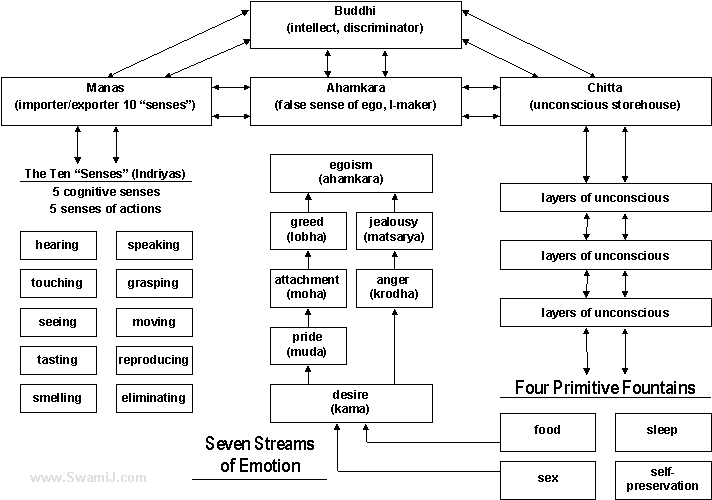
The “map” below is an attempt to summarize the inner process of mind according to Yoga in one graphic image or picture. Any “map” of the mind inherently says some things clearly, while missing other points. Please use this “map” in that light, so that you may find it useful on your own journey.
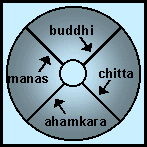
The four functions of mind are like spokes on a wheel. The wheel engages the world, while the center remains still.
There are Four Functions of Mind:
Manas = sensory, processing mind
Chitta = storage of impressions
Ahamkara = “I-maker” or Ego (2 Egos)
Buddhi = knows, decides, judges, and discriminates
Coordinating the Four Functions of Mind
by Swami Jnaneshvara Bharati
SwamiJ.com
Q: What is the one stance from which one can witness all of the Four Functions of Mind and the way in which senses, body, breath, and mind operate together? A: It is the Self, the Atman. To know that Self is the reason the Yogi does self-awareness and self-training. That Self is like the still center of a wheel, where the four spokes are the Four Functions of Mind that operate the external wheel in the world. | |||||
 The four functions of mind are like spokes on a wheel. The wheel engages the world, while the center remains still. |
| ||||
Index of this web page: See also these articles: | |||||
Discrimination and Self-Realization
An important part of meditation: When reading about the Four Functions of Mind, it can sound like this is merely an intellectual study. It is not. Witnessing the Four Functions of Mind is an important part of Yoga meditation.
Observing and discriminating between |
Discriminating between the four functions: This is one of the most profound self-awareness practices of the ancient Himalayan sages. This Yoga practice is just as profoundly useful today as it was thousands of years ago. The process is one of self-observation, and gradually discriminating between these four aspects of the inner instrument, so as to attain the direct experience of the Center of Consciousness from which all of our thoughts, emotions, and experiences arise on various degrees and grades.
Actively observe the four as they are operating: That Center is the Witness of these Four Functions of Mind. Ultimately, one comes to know that the only stance from which these can be fully observed is that of the Center itself. In Yoga meditation, the simple act of attempting to observe these Four Functions, as they function, is the key to the practice.
Mind is like Four Spokes on a Wheel
Like four spokes of a wheel: The Four Functions of Mind are like four spokes that drive the wheel to operate in the external road of life.
The hub remains still: While the wheel turns, the center hub remains still, like the center of consciousness, the Self, which remains still. While the hub is the source of the energy driving the wheel of life, the very center of the hub does not itself move.
Go through the spokes to get to the hub: To know the center or hub (the Self), one must go through the spokes. The only vantage point from which one may fully be witness to the spokes is the Self. One who knows that center hub through Yoga meditation knows the Self, which is called Self-Realization. Thus, the process of observation of the Four Functions of Mind is an extremely useful aspect of the path of Self-Realization.
Understanding the Four Functions of Mind
To understand the Four Functions of Mind, one needs to:
1) Observe each of the Four Functions of Mind.
2) Accept the nature of each of the Four Functions of Mind.
Train each of the four functions: One must not only observe, accept, and understand the functions of mind, but also train the four functions. To know and train the four functions, or spokes is essential for one to get to the center of the wheel. This is done systematically in the process of Yoga meditation.
Coordinating the Four Functions of Mind
To establish coordination among those functions of mind, one needs to:
1) Actions and speech: Watch the mind’s functioning through actions and speech.
2) Thinking process within: At the same time, observe the thinking process within.
Observing your actions and speech |
Observing mind through actions and speech: To watch the mind’s functioning through actions and speech means that the motions and words give a mirror reflection of what is going on in one’s own mind. Often, we watch the gestures and body language of other people, and infer what is going on inside that person. Though we might not always be exactly correct, we all do this with some degree of accuracy.
Observing gestures and body language: We can do the same thing with ourselves, learning of our inner mental and emotional states by observing our own gestures and body language, our own actions and speech.
While observing actions and speech, |
Observe the thinking process within: While we are observing our actions and speech so as to understand our inner states, we also can literally observe the thinking process within. For a Yoga meditator, this means
- At the moment operating: Observe the Four Functions of Mind at the moment they are operating.
- Independently: Observe the Four Functions of Mind independently of one another.
- As they interact: Observe the Four Functions of Mind as they interact with one another.
While this can take some time to learn, it is extremely fruitful when practiced for a while. It becomes very easy and natural to observe our actions, speech, and thoughts. It brings heightened awareness and a sense of inner peace.
Exploring the Four Spokes of Mind
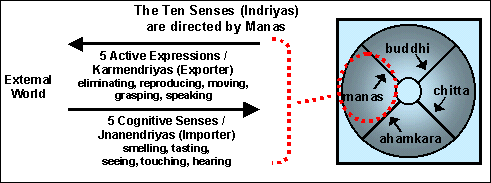
Manas, the lower mind: Manas is the lower mind, through which the mind interacts with the external world and takes in sensory impressions and data. Manas questions and doubts, which can cause great difficulties if this tendency becomes excessive.
Manas is the direct supervisor |
Manas is supervisor of the senses: Manas is like the supervisor in the factory of life, and directs the ten senses or Indriyas. Manas does a wonderful job of carrying out directions, but it is not supposed to be the key decision maker in the factory. That is the job of Buddhi. If Buddhi is clouded, then Manas has a habit of continuing to question, seeking good instruction. Then it often listens to whoever is speaking the loudest in the factory, which is the wants, wishes, desires, attractions, and aversions stored in the memory bank of Chitta.
Be mindful of actions and speech: A good way to cultivate the witnessing of Manas is to be mindful of actions and speech, as well as your senses of smelling, tasting, seeing, touching, and hearing. By observing these, you come to see how Manas is the one behind these actions and senses. Thus, Manas is like the supervisor of the employees in a factory. Manas is not the boss, but the supervisor, who is giving the direct orders to the active and cognitive senses.
Chitta
Chitta is the memory bank: Chitta is the memory bank, which stores impressions and experiences, and while it can be very useful, Chitta can also cause difficulties if its functioning is not coordinated with the others.
Chitta is the storage place |
Coordinating Chitta: If Chitta is not coordinated with the other functions of mind, then the thousands, millions, or countless impressions in this bed of the lake of mind start to stir and arise. It is as if these many latent impressions, coming to life are all competing for the attention of Manas to carry out their wants in the external world. In the absence of a clear Buddhi, the competing voices of Chitta often drive Manas to take actions in the world that are really not so useful.
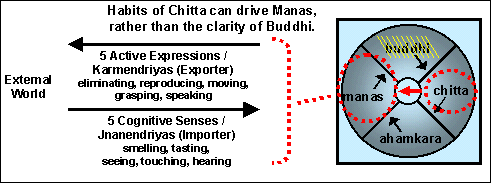
Witnessing Chitta: A good way to cultivate the witnessing of Chitta is to simply be aware of the streams of thoughts, emotions, images, and impressions that arise in front of Manas (on which Manas may or may not act). Notice how the stream of thoughts comes from somewhere, and then recedes back into that same place. This place is Chitta.
Yoga Sutras: In the Yoga Sutras, the term Yoga is defined with inclusion of the word Chitta, as Yogash chitta vritti nirodhah (See Yoga Sutra 1.2). Throughout the Yoga Sutras, the word chitta is used many times. By taking a quick look at those usages, the meaning of chitta becomes clearer.
- Here are links to some of the sutras that contain the word chitta: 1.2, 1.30, 1.33, 1.37, 3.9, 3.11, 3.12, 3.19, 3.35. 4.4, 4.5, 4.15, 4.16, 4.17, 4.18, 4.22, 4.23, 4.24, 4.26.
Ahamkara
Ahamkara is “I-am-ness,”: Ahamkara is the sense of “I-am-ness,” the individual Ego, which feels itself to be a distinct, separate entity. It provides identity to our functioning, but Ahamkara also creates our feelings of separation, pain, and alienation as well.
Ahamkara is the strong wave |
Ahamkara takes on partners: This wave of “I-am-ness” called Ahamkara then aligns itself or forms partnerships with the data or impressions in Chitta (causing them to be colored, or klishta), and, in turn, with Manas, which then responds to the desires being sought by this “individuality.” Meanwhile, Buddhi, the deep aspect, which knows, decides, and discriminates, remains clouded. Thus, it is said that purifying (or un-clouding) buddhi is a most important task in the path of meditation and Self-realization.
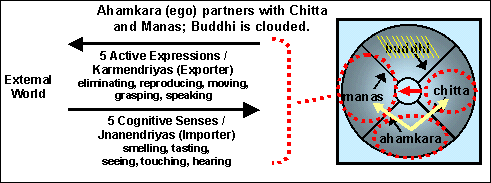
Witnessing the coloring by Ahamkara: A good way to cultivate the witnessing of Ahamkara is to be aware of the fact that rising thoughts and emotions are often colored with either attraction or aversion. The attraction or aversion may be strong, or it may be so weak that it is barely noticeable. Noticing the weak ones can be very insightful as to the subtlety of Ahamkara’s coloring (It’s much easier to neutrally witness the weak ones at first).
Buddhi
Buddhi is higher mind: Buddhi is the higher aspect of mind, the door-way to inner wisdom. The word Buddhi itself comes from the root budh, which means one who has awakened. Buddhi has the capacity to decide, judge, and make cognitive discriminations and differentiations. It can determine the wiser of two courses of action, if it functions clearly and if Manas will accept its guidance.
Buddhi is cultivated as the |
Buddhi should be the decision maker: In the factory of life, we want Buddhi to be making the choices for the factory. Otherwise, Manas gets its instructions from the habit patterns stored in Chitta, that are colored by Ahamkara, the Ego. Often, Buddhi is clouded over by all of the coloring and impressions in the Chitta. Thus, a major task of sadhana, spiritual practices, is to un-cloud the clouded Buddhi. Then, with clear choice one can ever improve the choices that lead to the fruits of spiritual practices.
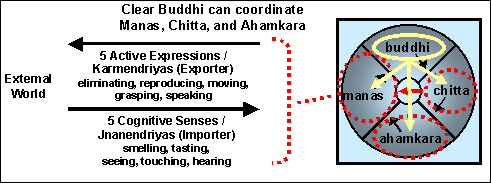
Depth of Buddhi: On the more gross or surface levels of living and meditation, Buddhi is used as a tool for discrimination, as just described. However, when we get deep enough in meditation, we discover that it was the subtlest aspect of Buddhi that first started to see division in ourselves and the universe. In other words, although Buddhi is used as a tool for deepening experience in meditation, it was Buddhi who carved up the universe in the first place, seeing division where there is unity. To discriminate between Buddhi and pure consciousness is one of the final stages in the meditative journey.
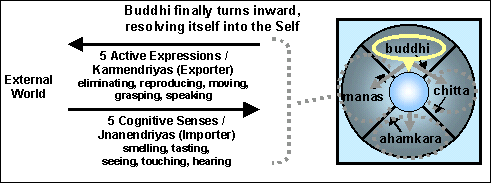
Yoga Sutras: The principle of Buddhi is one of the most important principles and tools of Yoga, as presented in the Yoga Sutras. The term Buddhi itself is only used a couple times in the Yoga Sutra, although Buddhi has to do with discrimination, or viveka, and that term is used several times. By reviewing those few sutras, it will become clear how the entire process is founded on discrimination and Buddhi.
- Here are links to the sutras using the word Buddhi: 4.21, 4.22.
- Here are links to the sutras using the word viveka: 2.26, 2.28, 3.53, 4.26, 4.29.
- It will also be useful to read all of these five sections: 2.26-2.29, 3.1-3.3, 3.4-3.6, 3.53-3.56, 4.22-4.26.
Two uses of the word “Ego”
“Ego” is used in two ways: To understand and effectively use the practice of witnessing the Four Functions of Mind (see the rest of this paper), it is important to note that there are two different ways of using the word Ego. To do this, we will use the metaphor of two houses.
Does “Ego” refer to |
Two houses: Imagine two houses that are exactly the same, except for the paint and the decorations.
- If we like the color of the paint on the house and the nature of the decorations, we say the house is pretty.
- If we do not like the color of the paint and the nature of the decorations, then we say the house is ugly.
Both are the same: However, both houses are actually the same as one another, underneath all of the surface appearances of paint and decorations.

- The paint and the decorations: In our common language and in the field of modern psychology, the word Ego generally refers to our personality structure. Thus, in our house metaphor, the Ego of psychology refers to the paint and decorations, with less regard for the existence of the house itself.
- The underlying house itself: In Yoga psychology, the word Ahamkara means the I-maker and refers to the powerful wave of individuated existence that declares “I am!” When the word Ahamkara is translated into English, we use the word Ego. Thus, in our house metaphor, the Ego of Yoga psychology, or Ahamkara, refers to the house itself, not to the paint and decorations, which are considered to be false identities.
Not just semantics: This important principle is not just semantics. When most of us hear the word Ego used to represent the word Ahamkara, we automatically, out of habit, project the wrong meaning onto the word Ego. If we only hear the word Ego, and have never previously encountered the word Ahamkara, we are even more blinded.
Both uses of the word are valid and useful: This is not a claim that one meaning of Ego is right and the other wrong. Both uses of the word Ego are valid within their own spheres. The principle of Ego in psychology is useful, and the principle of Ahamkara in Yoga psychology is useful. Also, using the word Ego for Ahamkara is also useful, so long as we remember the way the word is being used.
(The significance of this misuse of Ego for Ahamkara is further explained in the next section, on purifying Buddhi.)
Change |
Who is it that “wants” or “does not want”? We usually say, “I want this or that,” or “I don’t want this or that.” When we understand the way the four functions of mind interact, we come to see that it is not “I” who has attractions or aversions. That “I” is like the decorations on the house. It it the false identity aspect of “I” who is doing the wanting. The memory trace in the chitta, colored with attraction or aversion is, itself, the one who is doing the wanting. Thus, we can say, “It wants this or that,” or “It doesn’t want this or that.” It is the thought pattern itself that is wanting or not wanting, not I. This shift is extremely useful in witnessing the thought patterns so that colorings of attachment and aversion might be attenuated.
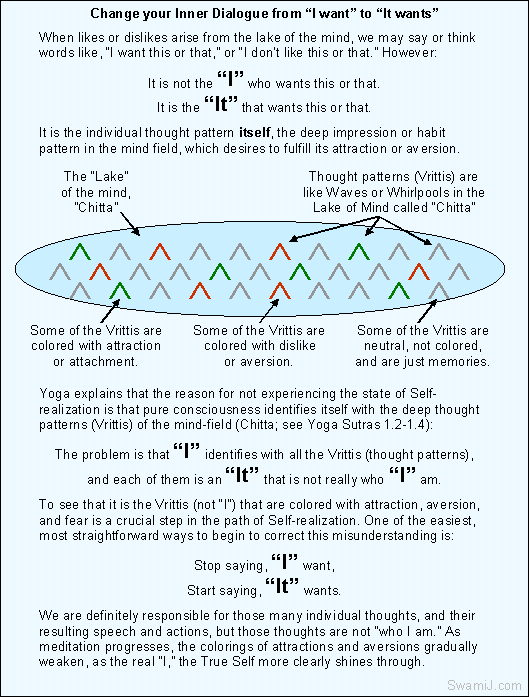
Purifying Buddhi is the most important task
Like the memories in Chitta: In Yoga psychology, the paint and decorations are like all of the impressions or memories stored in Chitta (in the house metaphor above).
Ahamkara makes a mistake: The Ahamkara (literally “I-maker”) makes a sort of mistake, by associating or identifying itself with some of those impressions in Chitta. (At a deeper level, it is the Self that makes this mistake, as described Yoga Sutra #4.)
The association between Ahamkara |
The association is the problem: This association between Ahamkara (Ego in Yoga science) and the data in Chitta, in turn, allows the emergence of the apparent individual personality (Ego in psychology). In this association, the impressions in Chitta are “colored” (klishta / 5 colorings) by Ahamkara with attractions and aversions. These colored impressions then compete for attention. In the absence of clear choice by Buddhi (knows, decides, judges, discriminates), the colored impressions drive Manas (sensory-motor mind) to take actions purely out of habit. (See also the article Uncoloring your Colored Thoughts)
The cause of our suffering: The entire cause of our mental and emotional suffering is the false identification between Ahamkara and the data that is stored in Chitta. (Eventually, at a deeper level, the Self is seen to have falsely identified itself with the Four Functions of Mind themselves). By witnessing the Four Functions of Mind, while they are functioning, we increasingly come to see this mistaken identity, which leads to freedom.
Buddhi becomes witness to this mistaken identity: It is the function of mind called Buddhi, which, once again, knows, decides, adjudges, and discriminates. In other words, Buddhi is the part that sees the situation clearly. Eventually, the Self or Atman is seen as witness to all of the Four Functions of Mind, including Buddhi itself.
Purifying Buddhi is the most important goal: How does this clarity come? It happens by removing the clouds of spiritual ignorance (avidya) that are blocking the wisdom of Buddhi. Thus, the most important goal of all practices is purifying Buddhi.
Killing or befriending the ego
Learn to be friends: In many systems of psychological or spiritual growth, there is the suggestion that one must “kill the ego.” In light of the two descriptions of ego above, and the process of purifying Buddhi, dealing with ego is done in a very different way. Rather than killing the ego, it is more like befriending the ego.
Ego needs to be trained: Remember, ego, as Ahamkara, is the “I-maker,” which allows for our very existence as individuals. The problem, as described above, is that ego mistakenly takes on false identities. It is not that ego is somehow bad, and needs to be punished by a death sentence. Rather, it needs to be trained, along with the other of the four functions of mind, particularly Manas.
Letting go of the associations: If there is to be a death at all, it is more like the letting go of the associations that have been made between the memories stored in Chitta and the I-ness of Ahamkara. This association is the coloring process known as klishta, as distinct from the un-coloring process known as aklishta.
Ahamkara becomes stronger: This “death” of association does not mean the death of Ahamkara. In fact, if anything, Ahamkara becomes stronger. People practicing Yoga often speak of kundalini awakening, which is an outpouring of kundalini shakti, with shakti being the primordial spiritual energy. However, there is a form of shakti that comes first, before kundalini shakti, and that is sankalpa shakti, which is the shakti of determination. It is that strong commitment on the spiritual journey that says, “I can do it! I will do it! I have to do it!” This is none other than the positive application of the force of Ahamkara, or ego. It is not a negative thing, which needs to die. Rather, it is a positive, essential tool, which needs to be trained, cultivated, and utilized on the inner journey.
This mistaken identity, and the process of un-coloring is a foundation principle of Yoga, and is the core of the practices described in the first few sutras of the Yoga Sutras (1.1-1.4).
Three freedoms
There are three freedoms that come sequentially over time through this purifying or clarity of Buddhi:
- Actions: First is freedom from the bondage of actions. As Ahamkara and Chitta become less associated through the colorings such as attachment and aversions (kleshas), there is greater freedom in actions.
- Thoughts: Second is freedom from the bondage of thoughts. The degree of the coloring further further attenuates through the process of un-clouding the Buddhi.
- Ignorance: Third is freedom from the bondage of ignorance (avidya). In this final stage, Buddhi has become so completely clear that it is able to see through all of the process of false identity.
Going Beyond the Mind
Mind directs, influences, and goes outward:
It is imperative that one become aware of the facts that:
- <class=”normal1″>Mind controls: It is the mind that is in direct control of the senses, breath, and body. </class=”normal1″>
- Mind goes outward: It is the mind that influences the senses and causes them to go out into the external world.
- Mind desires: It is the mind that desires to perceive the world through the senses and then to conceptualize and categorize those sense perceptions.
It’s all about training the mind: All sadhanas (spiritual practices), techniques, and disciplines are actually means to train the mind (all of the Four Functions of Mind).
Train mind to go beyond itself: The most important part of the training is to make the mind aware that Reality lies beyond itself, and that this Reality is the eternal aspect of the Self or Soul.
Mind is the finest instrument: The mind is the finest instrument that we possess. If it is understood well, the mind can be helpful in our spiritual practices (sadhana). However, the mind must be well-ordered and disciplined. Otherwise, the mind can distract and dissipate all of our potentials.
Levels of consciousness: The Four Functions of Mind operate at the various levels of consciousness. In the waking state of consciousness, the four operate. In the dreaming state, the four operate. In the deep sleep state, the four functions become less active, as if they are partially receding back into the latent part of mind, the Chitta from which all of the activity arises in the dreaming and waking states.
Experience the truth beyond the four functions: It is necessary that one learn to observe, understand, and train the functions of mind at the various levels of consciousness. Then, eventually, one can experience that Truth which is beyond all of the functions of mind and beyond the levels of waking, dreaming, and deep sleep.